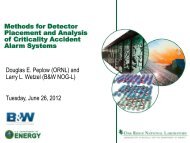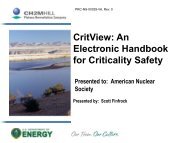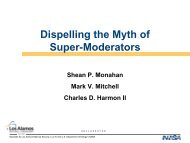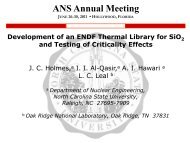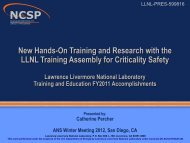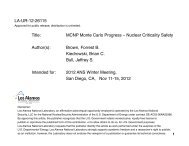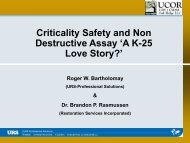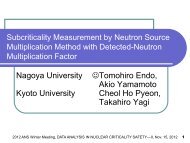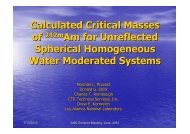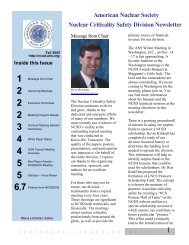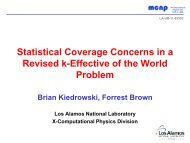results and analysis
results and analysis
results and analysis
Create successful ePaper yourself
Turn your PDF publications into a flip-book with our unique Google optimized e-Paper software.
BACKGROUND• HFIR Located at Oak Ridge National Laboratory• Purposes– Production of 252 Cf– Neutrons for research• Water moderated• Water cooled• Beryllium reflected
BACKGROUND
BACKGROUND
BACKGROUND• Core – two concentric annular fuelelements• Fuel – triuranium octoxide (U 3 O 8 ) <strong>and</strong>aluminum encapsulated in aluminumalloy plates
BACKGROUND
BACKGROUND
BACKGROUND
BACKGROUNDINNER FUEL ELEMENT• PLATE– 92 to 94 wt % 235 U enrichment– 15.18 g 235 U ± 1%– 0.0164 g 10 B ± 10%– 24 in. long by 3.626 in. wide by 0.050 in. thick– 19.978 in. long by 3.067 in. wide by 0.030 in. thick fuelbearing region
BACKGROUNDINNER FUEL ELEMENT• ASSEMBLY– 171 plates– 2.60 kg 235 U– 2.8 g 10 B
BACKGROUNDOUTER FUEL ELEMENT• PLATE– 92 to 94 wt % 235 U enrichment– 18.44 g 235 U ± 1%– No absorber– 24 in. long by 3.188 in. wide by 0.050 in. thick– 19.978 in. long by 2.762 in. wide by 0.030 in. thick fuelbearing region
BACKGROUNDOUTER FUEL ELEMENT• ASSEMBLY– 369 plates– 6.80 kg 235 U
EXPERIMENTALMEASUREMENTS• E. B. Johnson, “Critical Lattices of High FluxIsotope Reactor Fuel Elements,” ORNL/TM-1808 (March 20, 1967)• Oak Ridge Critical Experiments Facility logbook named “HFIR#2” archived as log book#35 (June 1966 through June 1967)
EXPERIMENTALMEASUREMENTS• ORNL/TM-1808– Planar lattices– 6 ft by 6 ft by 6 ft tank– Water moderator <strong>and</strong> reflector– Reflector “ . . . at least 6 in. thick on all sides.”
EXPERIMENTALMEASUREMENTS
EXPERIMENTALMEASUREMENTS
EXPERIMENTALMEASUREMENTSIDNumber<strong>and</strong>TypeLatticePatternSurfaceSeparation(in.)900 2 complete linear 3.60 k exabout 15 cents901 3 complete triangular 5.05 k ex= 9 cents902 4 complete square 5.05 k ex= 3 cents903a 7 complete triangular 6.37Remarks903b 7 complete triangular 6.40 about 17 cents subcritical903c 7 complete triangular 6.55 >28 cents subcritical904 3 outer triangular 0.00 k exabout 25 cents905 4 outer square 0.00 very subcritical906 7 outer triangular 1.50 critical907 7 inner triangular 1.16 very subcritical908a908b8 inner<strong>and</strong>8 outer8 inner<strong>and</strong>8 outersquare 1.39 subcriticalsquare 0.39 k ex> 75 cents
EXPERIMENTALMEASUREMENTS• LOG BOOK #35– Same as ORNL/TM-1808 except topwater reflector less than 6 in. thick– Top water height measured from “top offuel” level of 42.02 cm
EXPERIMENTALMEASUREMENTSIDNumberAndTypeLatticePatternSurface SeparationWaterHeightRelativeto Topof Plates(in.) (cm) (cm)900-1 2 complete linear 3 7.62 -2.4900-2 2 complete linear 3.6 9.144 2.8Remarks900-3 2 complete linear 3.95 10.033 11.6 8.2 ¢ subcritical901-1 3 complete triangular 5.050 12.827 4.95902-1 4 complete square 4.025 10.2235 -3.8902-2 4 complete square 4.535 11.5189 0.5902-3 4 complete square 5.045 12.8143 7.8
IDNumberAndTypeEXPERIMENTALMEASUREMENTSLatticePatternSurface SeparationWaterHeightRelativeto Topof Plates(in.) (cm) (cm)903-1 5 complete triangular 5.0 12.7 -2.2903-2 6 complete triangular 5.0 12.7 -3.0903-3 7 complete triangular 5.0 12.7 -4.4903-4 7 complete triangular 5.60 14.224 -1.5Remarks903-5 7 complete triangular 6.40 16.256 10.9 16.6 ¢ subcritical904-1 3 outer triangular 0 0 2.5906-1 7 outer triangular 0 0 -21.2906-2 7 outer triangular 1.06 2.6924 -11.0906-3 7 outer triangular 1.420 3.6068 1.5908b-18 innerAnd8 outersquare 0.39 0.9906 -6.6
EXPERIMENTALMEASUREMENTS• SUMMARIZING– ORNL/TM-1808: 12 c<strong>and</strong>idates– Log book #35: 17 c<strong>and</strong>idates
PREVIOUS WORK• KENO V.a code• 27 neutron energy group crosssections• Single region fuel model
PREVIOUS WORK
PREVIOUS WORKIDExperimentalComputedk expk calcσ calck calc/k exp900 1.00114 1.02288 0.00291 1.02172901 1.00068 1.02084 0.00269 1.02015902 1.00023 1.02868 0.00289 1.02839903a 1.00000 1.01766 0.00291 1.01766904 1.00190 1.02116 0.00286 1.01922905 Subcritical 0.98392 0.00302 -906 1.00000 1.02100 0.00256 1.02100907 Subcritical 0.96466 0.00291 -908a Subcritical 0.95317 0.00291 -
FUEL MODEL• Divide fueled regions into multiple equal radialthickness annuli• Using fueled region annuli radii, fuel distributiondata, fuel length, <strong>and</strong> number of fuel plates,determine 235 U mass <strong>and</strong> density in each annularregion• Homogenize uranium, aluminum alloy, absorber(inner fuel element only), <strong>and</strong> water within fueledregion annuli
FUEL MODEL
FUEL MODEL• SCOPING COMPUTATIONS– XSDRNPM one dimensional discrete ordinatescode– 27 <strong>and</strong> 238 neutron energy group cross sections– Number of distinct fuel zones– Aluminum alloy composition– 235 U enrichment
FUEL MODEL• NUMBER OF FUEL ZONES1.12Number of Neutron Energy Groups272381.11XSDRNPM keff1.11.091.080 5 10 15 20 25 30 35Number of Distinct Fuel Regions in Each Element (Inner <strong>and</strong> Outer)
FUEL MODEL• 6061 ALUMINUM ALLOY COMPOSITIONElementContent (wt%)min.max.Magnesium 0.8 1.2Silicon 0.4 0.8Titanium 0.15Chromium 0.04 0.35Manganese 0.15Iron 0.7Copper 0.15 0.4Zinc 0.25others (each) 0.05others (total 0.15Aluminumremainder
FUEL MODEL• ALUMINUM ALLOY COMPOSITIONZinc Contentk effPure Aluminum- 1.0909Average Impurity Modelno zinc 1.0889zinc added toiron1.0888Maximum Impurity Modelno zinc 1.0872zinc added toiron1.0869
FUEL MODEL• 235 U ENRICHMENT1.0931.092XSDRNPM keff1.0911.091.08991 91.5 92 92.5 93 93.5 94 94.5 95235 U Enrichment (wt % 235 U)
FUEL MODEL• DECISIONS BASED ON SCOPING COMPUTATIONS– 16 distinct fuel zones in each element– Average specification 6061 aluminum alloy model withzinc represented by iron• Alloy composition treatment k eff uncertainty = 0.0020• Zinc representation k eff uncertainty < 0.0005, assigned0.0005• Combined k eff uncertainty = 0.0021– 0.0009 Δk eff /1 wt% 235 U enrichment• 93.2 wt% → ±0.05 wt% uncertainty → Δk eff
VALIDATIONCOMPUTATIONS• SCALE CSAS25 computational sequence• 1030 generations/3000 neutrons per generation/30generations skipped• 27 neutron energy groups/1 fuel zone per fuel element• 27 neutron energy groups/16 fuel zones per element• 238 neutron energy groups/16 fuel zones per element
KENO Code keff 2RESULTS AND ANALYSIS1.061.051.04Comparison of 27 Neutron Energy Group ResultsPrevious Work - 1 Region Fuel ModelCurrent Work - 1 Region Fuel ModelCurrent Work - 16 Region Fuel Model1.031.021.0110.990.980.970.960.950.942 error bars are within theconfines of the open symbols0.930 2 4 6 8 10 12 14 16 18 20 22 24 26 28 30Index
KENO Code keff 2RESULTS AND ANALYSIS1.061.051.041.031.02Comparison of Current Work 16 Region Fuel Models27 Neutron Energy Groups238 Neutron Energy Groups 2 error bars are withinthe confines of the symbols1.0110.990.980.970.960.950.940.930 2 4 6 8 10 12 14 16 18 20 22 24 26 28 30Index
RESULTS AND ANALYSIS• Five not considered further– No reliable k eff value stated for comparison• “subcritical” – computed k eff < 0.97• “very subcritical” (2) – computed k eff < 0.97• “>28 cents subcritical”• “k ex > 75 cents” – computed k eff > 1.02• Three “about” cases retained– Within 25¢ of k eff = 1.0000
RESULTS AND ANALYSIS• Ratio of calculated k eff to experimentalk eff (k calc /k exp ) formed• “Energy of Average Lethargy ofFission” (EALF) from KENO outputselected as correlating parameter
RESULTS AND ANALYSISIndexCaseIDExp.k eff(k exp)EALF(eV)k calcσ calck calc/k exp1 900 1.00114 1.33637E-01 1.00190 0.00053 1.000762 900-1 1.00000 1.35681E-01 0.99871 0.00054 0.998713 900-2 1.00000 1.34066E-01 0.99961 0.00051 0.999614 900-3 0.99938 1.33898E-01 0.99809 0.00057 0.998715 901 1.00068 1.33686E-01 1.00050 0.00055 0.999826 901-1 1.00000 1.33973E-01 0.99861 0.00054 0.998617 902 1.00023 1.33749E-01 0.99839 0.00052 0.998168 902-1 1.00000 1.36143E-01 0.99696 0.00054 0.996969 902-2 1.00000 1.34807E-01 0.99884 0.00055 0.9988410 902-3 1.00000 1.33797E-01 0.99851 0.00053 0.9985111 903a 1.00000 1.33883E-01 0.99870 0.00050 0.9987012 903b 0.99871 1.34056E-01 0.99759 0.00055 0.9988814 903-1 1.00000 1.35823E-01 0.99582 0.00053 0.9958215 903-2 1.00000 1.35878E-01 0.99712 0.00053 0.99712
RESULTS AND ANALYSISIndexCaseIDExp.k eff(k exp)EALF(eV)k calcσ calck calc/k exp16 903-3 1.00000 1.36285E-01 0.99702 0.00051 0.9970217 903-4 1.00000 1.34788E-01 1.00304 0.00053 1.0030418 903-5 0.99874 1.34078E-01 0.99735 0.00052 0.9986119 904 1.00190 1.21957E-01 1.00525 0.00067 1.0033420 904-1 1.00000 1.22573E-01 1.00361 0.00066 1.0036122 906 1.00000 1.05593E-01 0.99682 0.00062 0.9968223 906-1 1.00000 1.35941E-01 0.99729 0.00062 0.9972924 906-2 1.00000 1.11860E-01 0.99922 0.00071 0.9992225 906-3 1.00000 1.06291E-01 1.00177 0.00055 1.0017729 908b-1 1.00000 1.07978E-01 1.00344 0.00063 1.00344
RESULTS AND ANALYSIS• No strong basis for determiningexperimental uncertainties• Previous work reviewers assigned ±0.00228“Value was unreported but equals a typicalexperimental uncertainty”• Scoping computations– Combined zinc <strong>and</strong> aluminum alloy uncertainty:0.0021– 235 U enrichment uncertainty:
RESULTS AND ANALYSIS• Spacing between units– Reported to 0.01 in. (implies ±0.005 in.) in openliterature– Recorded to 0.001 in. in log book– Computation (2 units) indicates approximatelylinear at 0.0086 Δk eff /in.– Uncertainty due to spacing
RESULTS AND ANALYSIS• Fuel Plate/Water Channel ThicknessVariations– Manufacturing specifications• Nominal 0.050 in. thick fuel plate/0.050 in. thickwater channel• “Maximum plate thickness variability 0.001 in.”• Minimum cladding thickness >0.007 in.• Average coolant channel thickness between0.049 in. <strong>and</strong> 0.051 in.
RESULTS AND ANALYSIS• Fuel Plate/Water Channel ThicknessVariations– Computed 0.0104 Δ keff /0.001 in. claddingthickness (>100¢/0.001 in.)
RESULTS AND ANALYSISFuel Plate/Water Channel Thickness VariationsMeasured Reactivities of Individual AssembliesElementNumberReactivity(cents)4 -201.8 ± 12.85 -203.8 ± 14.46 -196.1 ± 14.77 -200.7 ± 13.28 -189.6 ± 16.69 -191.1 ± 13.410 -182.1 ± 12.611 -186.0 ± 15.6
KENO Code keff 2RESULTS AND ANALYSISFuel Plate/Water Channel Thickness Variations1.01Fuel Plate/Water Channel Thickness Model ComputationsAverage of Measured Values2 for Average of Measured Values10.990.980.970.960.007 0.008 0.009 0.01 0.011 0.012 0.013Cladding Thickness (in.)
RESULTS AND ANALYSIS• Derived uncertainty ±0.0021 comparedto previous work reviewer assigned±0.00228– are they reasonable?
RESULTS AND ANALYSIS• Survey uncertainty ranges for benchmarksystems– “International H<strong>and</strong>book of Evaluated CriticalitySafety Benchmark Experiments”– Highly enriched uranium thermal systems– Eighteen metal systems: ±0.0005 to ±0.0070– Forty four solution systems: ±0.0019 to ±0.0152• Previous work assigned ±0.00228– Toward lower end of range experience– Not unreasonable
RESULTS AND ANALYSISIndexCaseIDExp.k eff(k exp)EALF(eV)k calcσ calck calc/k expσ calc/exp1 900 1.00114 1.33637E-01 1.00190 0.00053 1.00076 0.002342 900-1 1.00000 1.35681E-01 0.99871 0.00054 0.99871 0.002343 900-2 1.00000 1.34066E-01 0.99961 0.00051 0.99961 0.002344 900-3 0.99938 1.33898E-01 0.99809 0.00057 0.99871 0.002355 901 1.00068 1.33686E-01 1.00050 0.00055 0.99982 0.002346 901-1 1.00000 1.33973E-01 0.99861 0.00054 0.99861 0.002347 902 1.00023 1.33749E-01 0.99839 0.00052 0.99816 0.002338 902-1 1.00000 1.36143E-01 0.99696 0.00054 0.99696 0.002349 902-2 1.00000 1.34807E-01 0.99884 0.00055 0.99884 0.0023410 902-3 1.00000 1.33797E-01 0.99851 0.00053 0.99851 0.0023411 903a 1.00000 1.33883E-01 0.99870 0.00050 0.99870 0.0023312 903b 0.99871 1.34056E-01 0.99759 0.00055 0.99888 0.00235
RESULTS AND ANALYSISIndexCaseIDExp.k eff(k exp)EALF(eV)k calcσ calck calc/k expσ calc/exp14 903-1 1.00000 1.35823E-01 0.99582 0.00053 0.99582 0.0023315 903-2 1.00000 1.35878E-01 0.99712 0.00053 0.99712 0.0023316 903-3 1.00000 1.36285E-01 0.99702 0.00051 0.99702 0.0023317 903-4 1.00000 1.34788E-01 1.00304 0.00053 1.00304 0.0023518 903-5 0.99874 1.34078E-01 0.99735 0.00052 0.99861 0.0023419 904 1.00190 1.21957E-01 1.00525 0.00067 1.00334 0.0023820 904-1 1.00000 1.22573E-01 1.00361 0.00066 1.00361 0.0023822 906 1.00000 1.05593E-01 0.99682 0.00062 0.99682 0.0023623 906-1 1.00000 1.35941E-01 0.99729 0.00062 0.99729 0.0023624 906-2 1.00000 1.11860E-01 0.99922 0.00071 0.99922 0.0023925 906-3 1.00000 1.06291E-01 1.00177 0.00055 1.00177 0.0023529 908b-1 1.00000 1.07978E-01 1.00344 0.00063 1.00344 0.00237
RESULTS AND ANALYSIS• k calc /k exp arithmetic average = 0.9993• USLSTATS code– Available at SCALE web site– Described in NUREG/CR-6361, ORNL/TM-13122, “Criticality Benchmark Guide for Light-Water-Reactor Fuel in Transportation <strong>and</strong>Storage Packages,” Appendix C
RESULTS AND ANALYSIS• USLSTATS produces UpperSubcritical Limits as:– Confidence B<strong>and</strong> with AdministrativeMargin (USL 1 )– Lower Tolerance B<strong>and</strong> (USL 2 )
RESULTS AND ANALYSIS1.02USL 1 with no administrative marginUSL 21.01kcalc/kexp 210.990.980.970.961E-1 1.05E-1 1.1E-1 1.15E-1 1.2E-1 1.25E-1 1.3E-1 1.35E-1 1.4E-1EALF (eV)
RESULTS AND ANALYSIS• Recommended round USL 2 down to0.98 for application within EALF rangecovered• For “short” distances outside EALFrange, use USL 1 with administrativemargin evaluated for application
CONCLUSIONS• 7 open literature experiments supplementedby 17 additional experiments derived fromlog book• Fuel model with markedly reduced bias thanpreviously observed derived• Relatively high USL derived for application
Questions, Comments, Observations?




